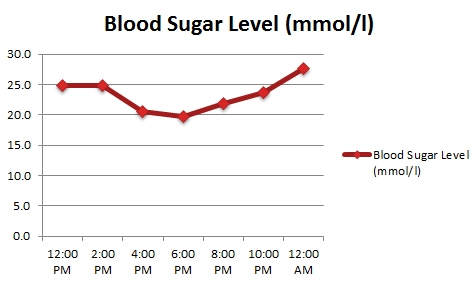Blood Sugar Curve
Written by: Dr Audrey Harvey BVSc (Hons)
 Your diabetic cat will need regular blood tests to make sure his insulin dose is correct. If he has too much insulin, his blood glucose will be too low. On the other hand, not enough of this hormone will result in high blood glucose and the return of the symptoms of diabetes.
Your diabetic cat will need regular blood tests to make sure his insulin dose is correct. If he has too much insulin, his blood glucose will be too low. On the other hand, not enough of this hormone will result in high blood glucose and the return of the symptoms of diabetes.
One diabetes blood test that is commonly performed is the glucose curve. This involves collecting a blood sample every two hours for a 12-hour period. The first sample should be collected before your cat’s morning dose of insulin, and the last one just before his evening injection.
It can take a few days for cat blood sugar levels to settle down after a change in diet or insulin dose. This means that glucose curves shouldn’t be done within 10 days of such a change. When your cat is first diagnosed with diabetes, tests may need to be done every day to work out the right dose of insulin for him. When his blood glucose levels have stabilized, you shouldn’t need to check them any more frequently than every two weeks.
Your veterinarian can perform this cat blood test in their clinic, but there are disadvantages to this. Firstly, your cat will need to spend a full day in hospital. That can be stressful for him, and he may not feel like eating. The result is an inaccurate test result. Secondly, if he needs a diabetes blood test on a regular basis, the cost can quickly add up. You can easily master the technique of performing a glucose curve at home and save you and your cat a trip to the vet. Ask your vet to watch you for the first few times, so you can be confident you are doing it correctly.
To perform a diabetes blood test on your cat, you will need a glucometer and the appropriate test strips, as well as a sterile lancet. Make sure you have read the instruction manual for your glucometer, and know how to use it.

2Pac’s Blood Sugar Curve
Rub your cat’s ears gently for a few moments before you take the blood sample. This has two effects. It will relax him, and the ears will become slightly warmer which will dilate the veins in that area.
Use a torch and shine the light through his ear flap. You’ll notice the red vein running along the edge of the ear. Using a lancet at a 45-degree angle, quickly puncture the vein and capture a drop of blood on your test strip. Follow the directions in your glucometer manual and check the amount of glucose in your cat’s blood. Don’t forget to write down the results, so your vet can use them to work out the appropriate insulin dose.
It may sound painful, but checking cat blood sugar levels at home in this way doesn’t seem to distress them too much at all. If you stay calm and relaxed, your cat is likely to feel the same way which will make it so much easier for both of you.
Diabetes in felines is a common medical condition, and it can be expensive to monitor. It is a good idea to learn to perform blood glucose curves at home. You’ll save money, and your cat won’t be as stressed.
